Which B2 Fractures Can Be Treated with ORIF? Validation of the “Beyond the Vancouver Classification”
Abstract
1. Introduction
2. Materials and Methods
2.1. Study Design
2.2. Radiographic and Clinical Evaluation
2.3. Primary and Secondary Outcome
2.4. Statistical Analysis
3. Results
4. Discussion
4.1. B2 ‘Stable’ Stems
4.2. B2 ‘Loose’ Stems
4.3. Strength and Limitations
5. Conclusions
Author Contributions
Funding
Institutional Review Board Statement
Informed Consent Statement
Data Availability Statement
Conflicts of Interest
References
- Chatziagorou, G.; Lindahl, H.; Garellick, G.; Karrholm, J. Incidence and demographics of 1751 surgically treated periprosthetic femoral fractures around a primary hip prosthesis. Hip Int. 2019, 29, 282–288. [Google Scholar] [CrossRef] [PubMed]
- Lunebourg, A.; Mouhsine, E.; Cherix, S.; Ollivier, M.; Chevalley, F.; Wettstein, M. Treatment of type B periprosthetic femur fractures with curved non-locking plate with eccentric holes: Retrospective study of 43 patients with minimum 1-year follow-up. Orthop. Traumatol. Surg. Res. 2015, 101, 277–282. [Google Scholar] [CrossRef] [PubMed]
- Della Rocca, G.J.; Leung, K.S.; Pape, H.C. Periprosthetic fractures: Epidemiology and future projections. J. Orthop. Trauma. 2011, 25 (Suppl. S2), S66–S70. [Google Scholar] [CrossRef] [PubMed]
- Baba, T.; Homma, Y.; Momomura, R.; Kobayashi, H.; Matsumoto, M.; Futamura, K.; Mogami, A.; Kanda, A.; Morohashi, I. New classification focusing on implant designs useful for setting therapeutic strategy for periprosthetic femoral fractures. Int. Orthop. 2015, 39, 1–5. [Google Scholar] [CrossRef]
- Duncan, C.P.; Haddad, F.S. The Unified Classification System (UCS): Improving our understanding of periprosthetic fractures. Bone Jt. J. 2014, 96-B(6), 713–716. [Google Scholar] [CrossRef]
- Gonzalez-Martin, D.; Pais-Brito, J.L.; Gonzalez-Casamayor, S.; Guerra-Ferraz, A.; Ojeda-Jimenez, J.; Herrera-Perez, M. New Sub-Classification of Vancouver B2 Periprosthetic Hip Fractures According to Fracture Pattern. Injury 2022, 53, 1218–1224. [Google Scholar] [CrossRef]
- Lindahl, H.; Malchau, H.; Herberts, P.; Garellick, G. Periprosthetic femoral fractures classification and demographics of 1049 periprosthetic femoral fractures from the Swedish National Hip Arthroplasty Register. J. Arthroplast. 2005, 20, 857–865. [Google Scholar] [CrossRef]
- Ninan, T.M.; Costa, M.L.; Krikler, S.J. Classification of femoral periprosthetic fractures. Injury 2007, 38, 661–668. [Google Scholar] [CrossRef]
- Duncan, C.P.; Masri, B.A. Fractures of the femur after hip replacement. Instr. Course Lect. 1995, 44, 293–304. [Google Scholar]
- Lindahl, H.; Garellick, G.; Regner, H.; Herberts, P.; Malchau, H. Three hundred and twenty-one periprosthetic femoral fractures. J. Bone Jt. Surg. Am. 2006, 88, 1215–1222. [Google Scholar] [CrossRef]
- Stoffel, K.; Horn, T.; Zagra, L.; Mueller, M.; Perka, C.; Eckardt, H. Periprosthetic fractures of the proximal femur: Beyond the Vancouver classification. EFORT Open Rev. 2020, 5, 449–456. [Google Scholar] [CrossRef] [PubMed]
- Chatziagorou, G.; Lindahl, H.; Karrholm, J. Surgical treatment of Vancouver type B periprosthetic femoral fractures: Patient characteristics and outcomes of 1381 fractures treated in Sweden between 2001 and 2011. Bone Jt. J. 2019, 101-B(11), 1447–1758. [Google Scholar] [CrossRef] [PubMed]
- Baum, C.; Leimbacher, M.; Kriechling, P.; Platz, A.; Cadosch, D. Treatment of Periprosthetic Femoral Fractures Vancouver Type B2: Revision Arthroplasty Versus Open Reduction and Internal Fixation With Locking Compression Plate. Geriatr. Orthop. Surg. Rehabil. 2019, 10, 2151459319876859. [Google Scholar] [CrossRef] [PubMed]
- Park, S.K.; Kim, Y.G.; Kim, S.Y. Treatment of periprosthetic femoral fractures in hip arthroplasty. Clin. Orthop. Surg. 2011, 3, 101–106. [Google Scholar] [CrossRef]
- Gonzalez-Martin, D.; Hernandez-Castillejo, L.E.; Herrera-Perez, M.; Pais-Brito, J.L.; Gonzalez-Casamayor, S.; Garrido-Miguel, M. Osteosynthesis versus revision arthroplasty in Vancouver B2 periprosthetic hip fractures: A systematic review and meta-analysis. Eur. J. Trauma. Emerg. Surg. 2023, 49, 87–106. [Google Scholar] [CrossRef]
- Joestl, J.; Hofbauer, M.; Lang, N.; Tiefenboeck, T.; Hajdu, S. Locking compression plate versus revision-prosthesis for Vancouver type B2 periprosthetic femoral fractures after total hip arthroplasty. Injury 2016, 47, 939–943. [Google Scholar] [CrossRef]
- Eckardt, H.; Windischbauer, D.; Morgenstern, M.; Stoffel, K.; Clauss, M. Analysis of complications in 97 periprosthetic Vancouver B2 fractures treated either by internal fixation or revision arthroplasty. Arch. Orthop. Trauma Surg. 2024, 144, 1647–1653. [Google Scholar] [CrossRef]
- Flury, A.; Hasler, J.; Pagenstert, G.; Dimitriou, D.; Helmy, N.; Finsterwald, M. Open reduction and internal fixation might be a valuable alternative to stem revision in Vancouver B2 periprosthetic femoral fractures, irrespective of the stem’s design. Arch. Orthop. Trauma. Surg. 2021, 141, 871–878. [Google Scholar] [CrossRef]
- Prokopetz, J.J.; Losina, E.; Bliss, R.L.; Wright, J.; Baron, J.A.; Katz, J.N. Risk factors for revision of primary total hip arthroplasty: A systematic review. BMC Musculoskelet. Disord. 2012, 13, 251. [Google Scholar] [CrossRef]
- Marshall, R.A.; Weaver, M.J.; Sodickson, A.; Khurana, B. Periprosthetic Femoral Fractures in the Emergency Department: What the Orthopedic Surgeon Wants to Know. Radiographics 2017, 37, 1202–1217. [Google Scholar] [CrossRef]
- Lovelock, T.M.; Broughton, N.S. Follow-up after arthroplasty of the hip and knee: Are we over-servicing or under-caring? Bone Jt. J. 2018, 100-B(1), 6–10. [Google Scholar] [CrossRef] [PubMed]
- Lewis, D.P.; Tarrant, S.M.; Cornford, L.; Balogh, Z.J. Management of Vancouver B2 Periprosthetic Femoral Fractures, Revision Total Hip Arthroplasty Versus Open Reduction and Internal Fixation: A Systematic Review and Meta-Analysis. J. Orthop. Trauma. 2022, 36, 7–16. [Google Scholar] [CrossRef] [PubMed]
- Beals, R.K.; Tower, S.S. Periprosthetic fractures of the femur. An analysis of 93 fractures. Clin. Orthop. Relat. Res. 1996, 327, 238–246. [Google Scholar] [CrossRef] [PubMed]
- Lenhard, W.; Lenhard, A. Computation of Effect Sizes. 2022. Available online: https://www.psychometrica.de/effect_size.html (accessed on 9 July 2024).
- Vioreanu, M.H.; Parry, M.C.; Haddad, F.S.; Duncan, C.P. Field testing the Unified Classification System for peri-prosthetic fractures of the pelvis and femur around a total hip replacement: An international collaboration. Bone Jt. J. 2014, 96-B(11), 1472–1477. [Google Scholar] [CrossRef]
- Jain, S.; Mohrir, G.; Townsend, O.; Lamb, J.N.; Palan, J.; Aderinto, J.; Pandit, H. Reliability and validity of the Unified Classification System for postoperative periprosthetic femoral fractures around cemented polished taper-slip stems. Bone Jt. J. 2021, 103-B(8), 1339–1344. [Google Scholar] [CrossRef]
- Quah, C.; Porteous, M.; Stephen, A. Principles of managing Vancouver type B periprosthetic fractures around cemented polished tapered femoral stems. Eur. J. Orthop. Surg. Traumatol. 2017, 27, 477–482. [Google Scholar] [CrossRef]
- Scott, C.E.H.; Jain, S.; Moran, M.; Haddad, F.S. Which Unified Classification System type B periprosthetic fractures around cemented polished tapered stems should not be fixed? Bone Jt. J. 2023, 105-B(5), 481–486. [Google Scholar] [CrossRef]
- Maggs, J.L.; Swanton, E.; Whitehouse, S.L.; Howell, J.R.; Timperley, A.J.; Hubble, M.J.W.; Wilson, M.J. B2 or not B2? That is the question: A review of periprosthetic fractures around cemented taper-slip femoral components. Bone Jt. J. 2021; 103-B(1), 71–78. [Google Scholar] [CrossRef]
- Spina, M.; Scalvi, A. Vancouver B2 periprosthetic femoral fractures: A comparative study of stem revision versus internal fixation with plate. Eur. J. Orthop. Surg. Traumatol. 2018, 28, 1133–1142. [Google Scholar] [CrossRef]
- Khanuja, H.S.; Vakil, J.J.; Goddard, M.S.; Mont, M.A. Cementless femoral fixation in total hip arthroplasty. J. Bone Jt. Surg. Am. 2011, 93, 500–509. [Google Scholar] [CrossRef]
- Baba, T.; Kaneko, K.; Homma, Y.; Ochi, H.; Ozaki, Y.; Watari, T.; Matsumoto, M. The Baba classification focused on implant designs is useful in setting the therapeutic strategy for interprosthetic femoral fracture. Eur. J. Orthop. Surg. Traumatol. 2018, 28, 247–254. [Google Scholar] [CrossRef]
- Karam, J.; Campbell, P.; Desai, S.; Hunter, M. Periprosthetic proximal femoral fractures in cemented and uncemented stems according to Vancouver classification: Observation of a new fracture pattern. J. Orthop. Surg. Res. 2020, 15, 100. [Google Scholar] [CrossRef]
- Noda, M.; Saegusa, Y.; Takahashi, M.; Noguchi, C.; Yoshikawa, C.; Mikami, H.; Gotouda, A. Comparison of Post-Operative Muscular Strength Between Gamma Nailing and Hemiarthroplasty System in Femoral Intertrochanteric Fractures. Open Orthop. J. 2017, 11, 255–262. [Google Scholar] [CrossRef] [PubMed]
- Patel, N.; Golwala, P. Hip Abductor Muscle Strength Recovery: A Comparison Between Joint Replacement Surgery and Internal Fixation Surgery. Cureus 2024, 16, e59120. [Google Scholar] [CrossRef] [PubMed]
- Stasi, S.; Papathanasiou, G.; Chronopoulos, E.; Galanos, A.; Papaioannou, N.A.; Triantafyllopoulos, I.K. Association between abductor muscle strength and functional outcomes in hip-fractured patients: A cross-sectional study. J. Musculoskelet. Neuronal Interact. 2018, 18, 530–542. [Google Scholar] [PubMed]

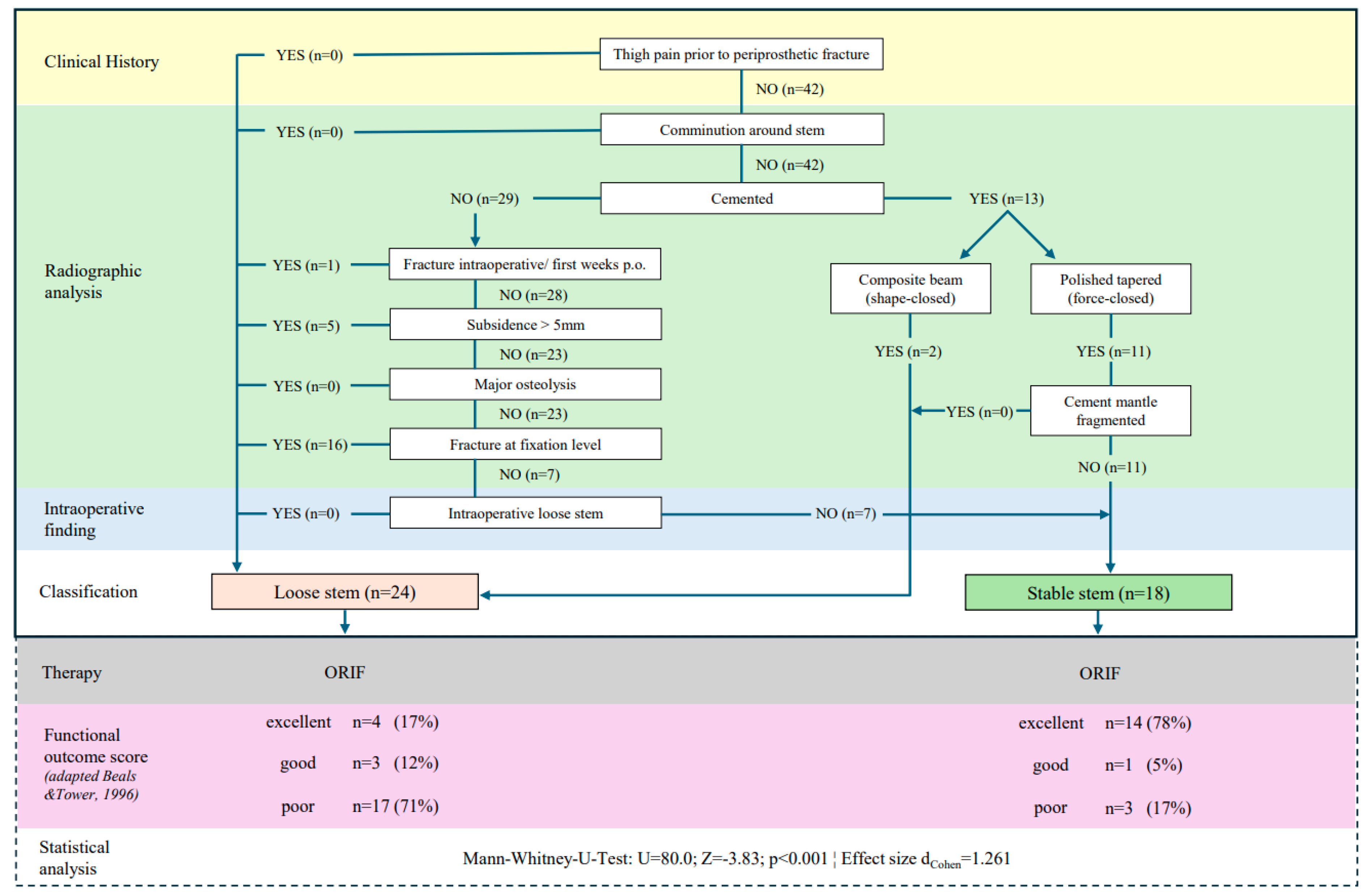
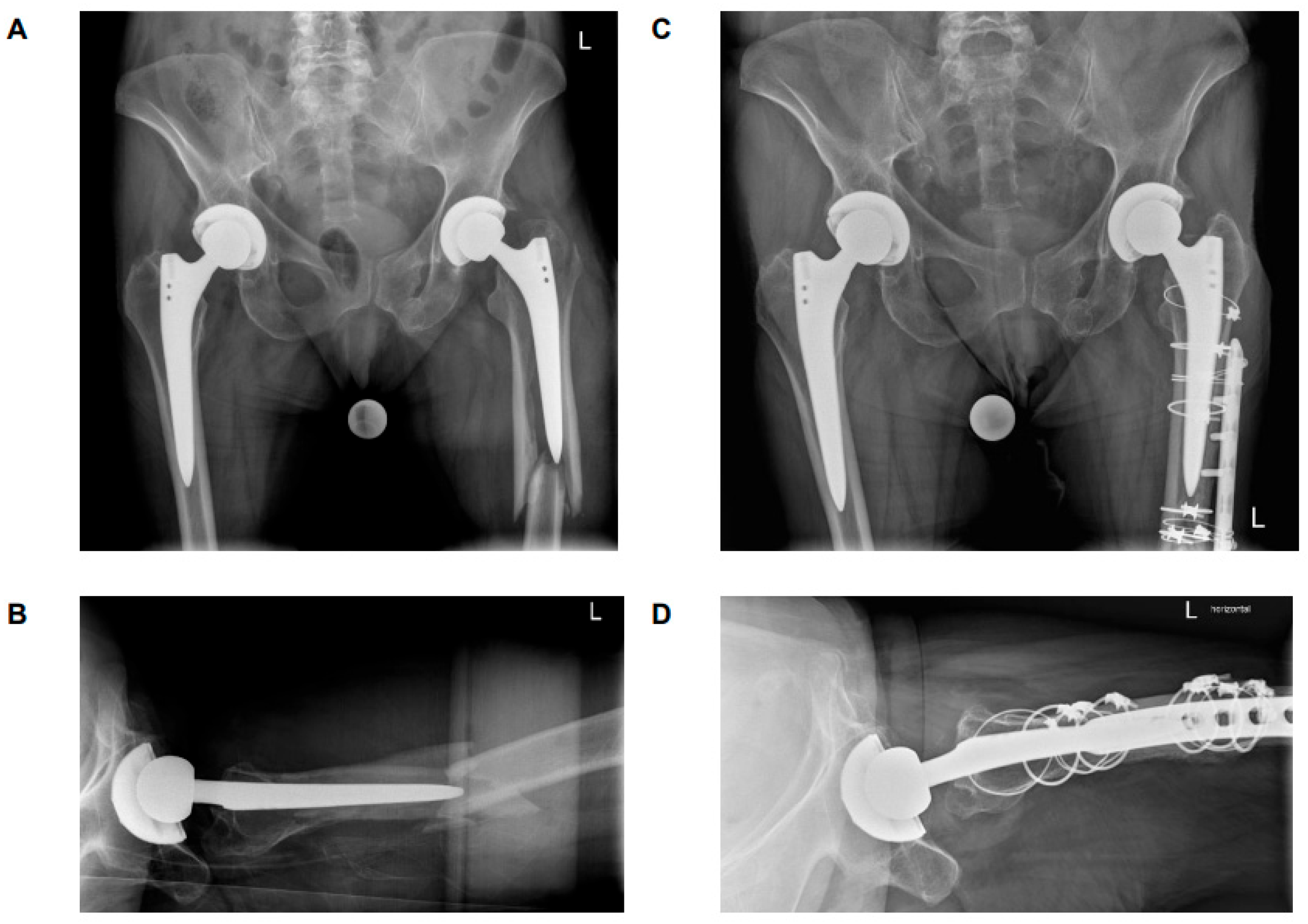
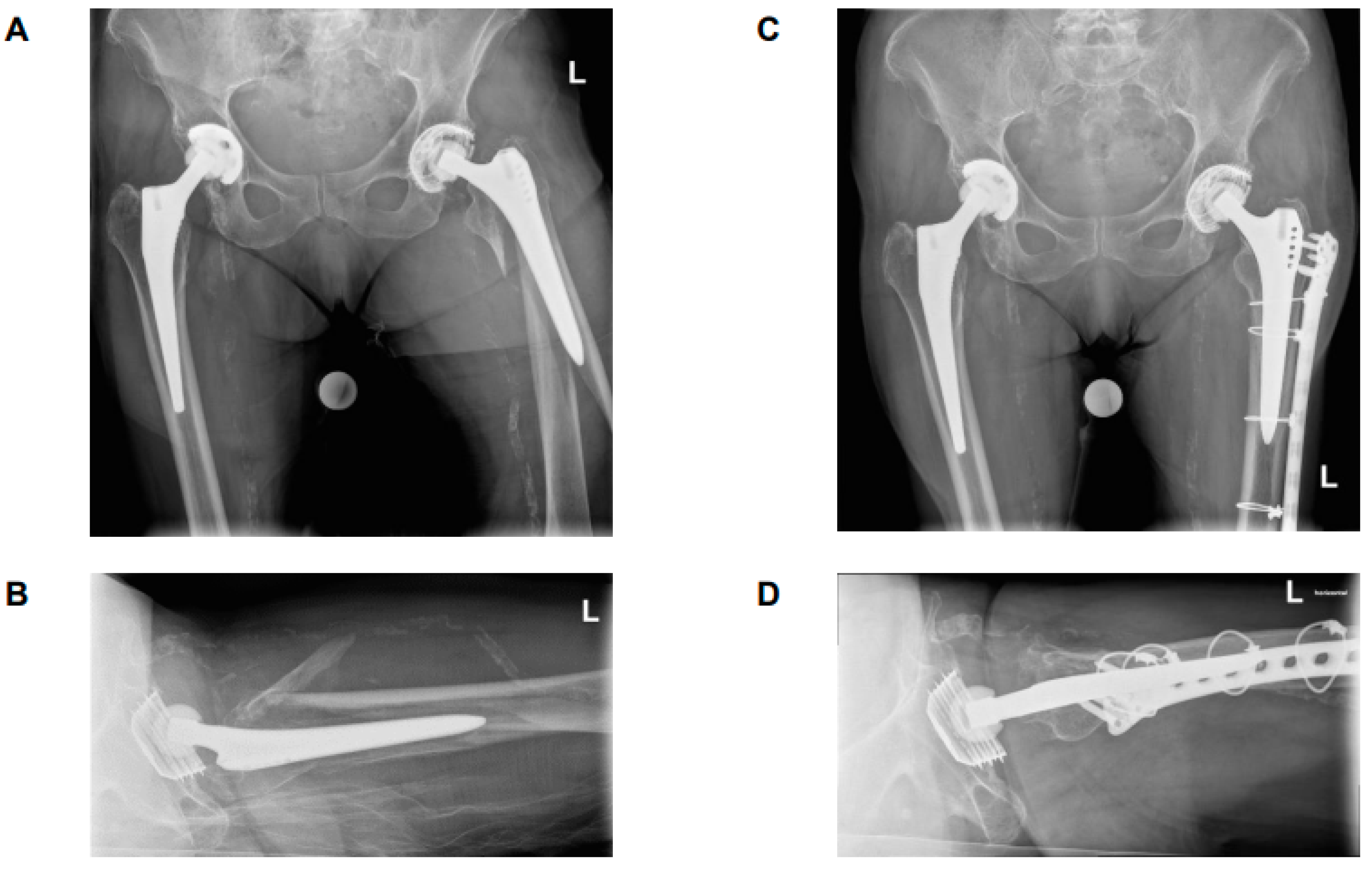
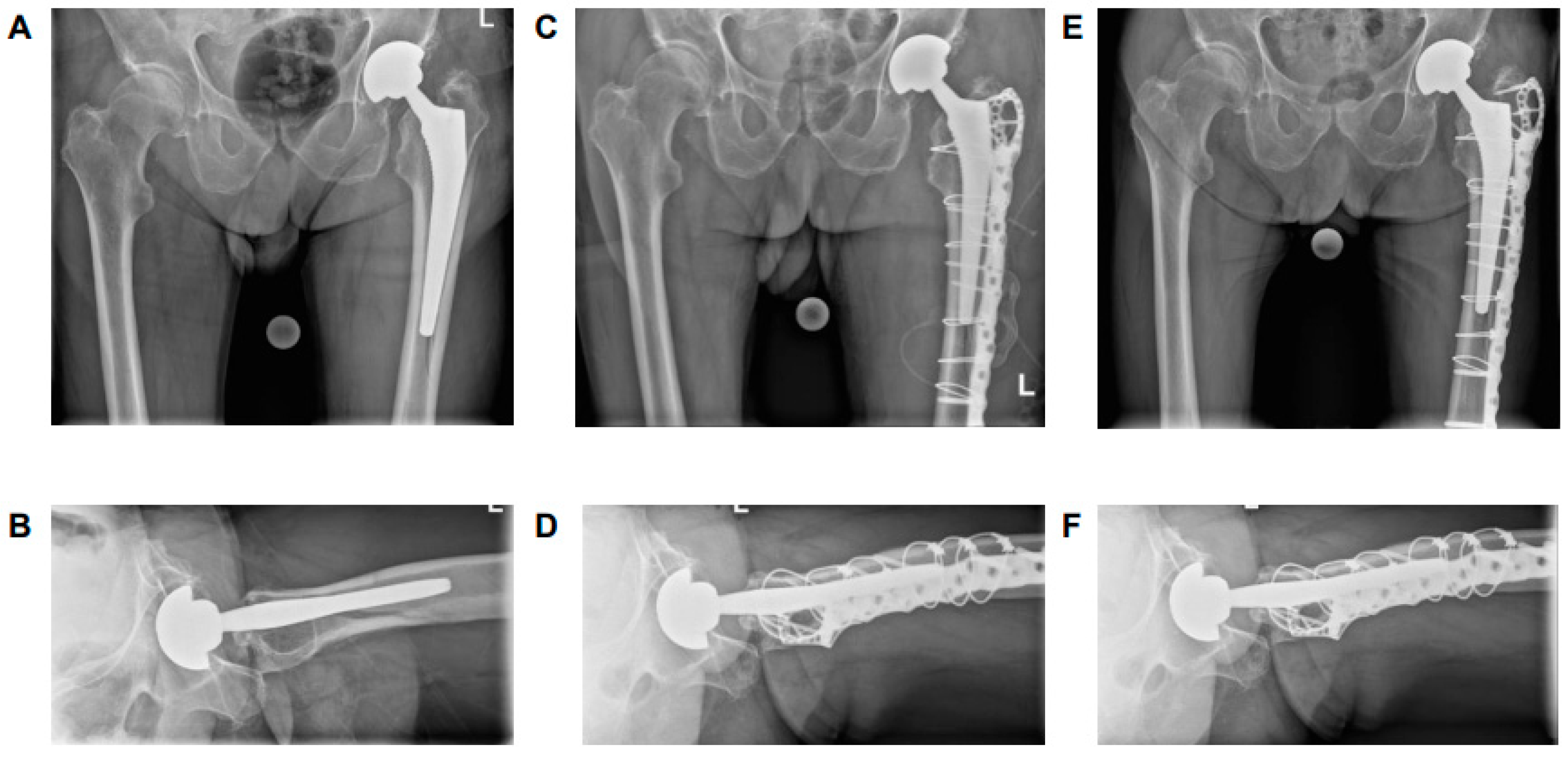
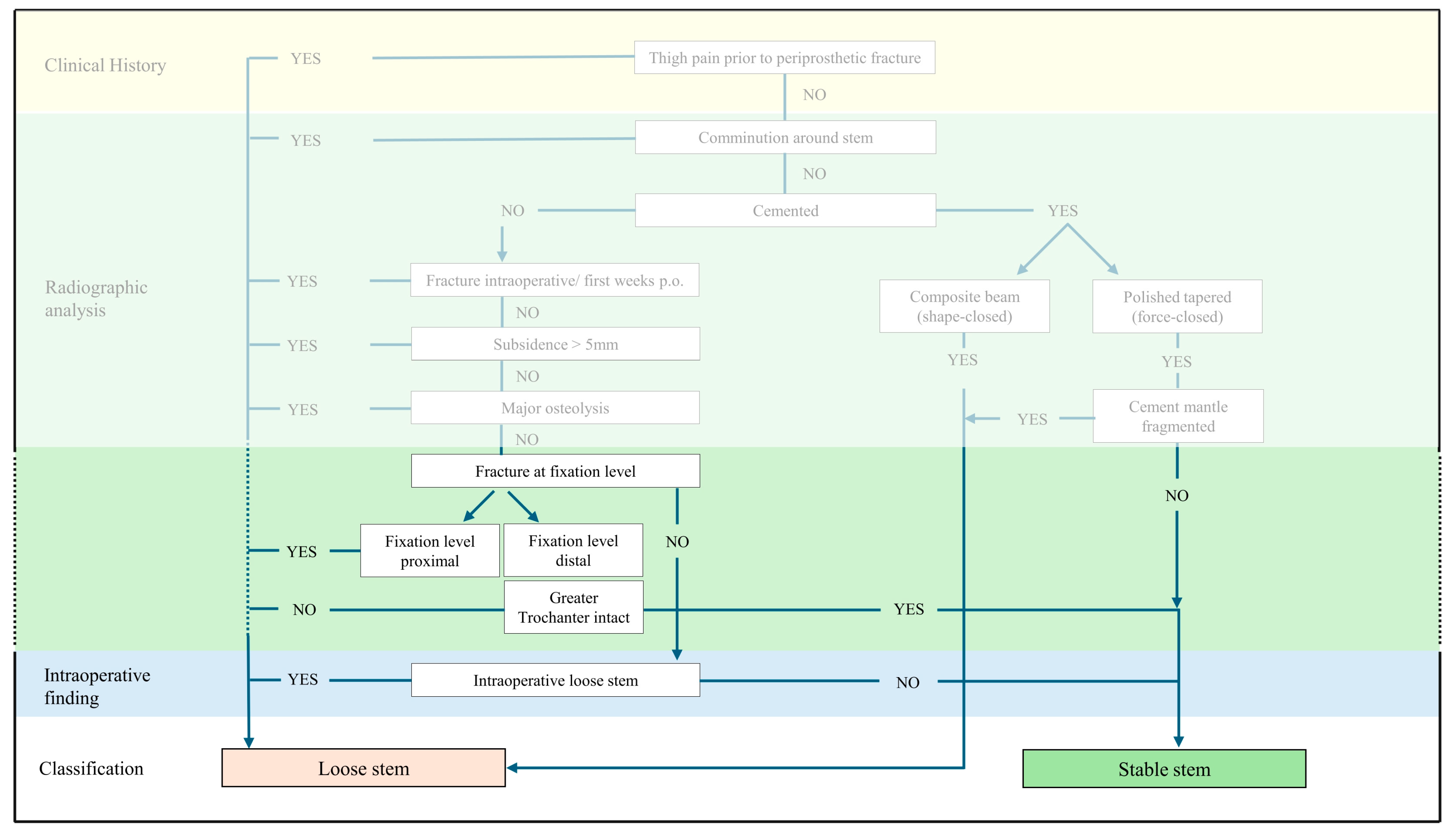
| Age at fracture (years) | Median (range) 83 (73–88) years |
| Gender | Number (%) |
| Female | 25 (60%) |
| Male | 17 (40%) |
| ASA classification | ASA 1: 1 (2%) |
| ASA 2: 19 (45%) | |
| ASA 3: 22 (52%) | |
| Type of primary stem | Number (%) |
| Cemented | 12 (29%) |
| Cementless | 30 (71%) |
| Lifetime of existing prosthesis | Median (range) 78 months (4–134 months) |
| Time between ORIF and last follow-up | Median (range) 24 weeks (12–36 weeks) |
| Clinical | Functional | ||||||
|---|---|---|---|---|---|---|---|
| Arthroplasty | Fracture and Complication | Mobility | Pain | ||||
| Excellent | Stable (no Osteolysis, Subsidence <5 mm) | and | Healed Minimal deformity No shortening | and | Limp-free Unrestricted walking or short distances out of home | and | No or minimal pain |
| Good | Stable Subsidence (5–10 mm) | or | Healed Moderate deformity Moderate shortening | or | Slight limp Rollator Short distances at home | or | Little pain |
| Poor | Loose Subsidence > 10 mm | or | Non-union Sepsis New Fracture Severe deformity Severe shortening | or | Limping Wheelchair | or | Pain |
| Parameter | Number (%) | Number (%) | Number (%) |
|---|---|---|---|
| Overall (n = 42) | B2 ‘loose’ (n = 24) | B2 ‘stable’ (n = 18) | |
| Overall Functional Outcome Score * | |||
| Excellent | 18 (43%) | 4 (17%) | 14 (78%) |
| Good | 4 (10%) | 3 (13%) | 1 (6%) |
| Poor | 20 (48%) | 17 (71%) | 3 (17%) |
| Complications postoperative | |||
| Infection | 4 (10%) | 2 (8%) | 2 (11%) |
| Revision | 5 (12%) | 4 (17%) | 1 (6%) |
| Stem subsidence at time of fracture | |||
| >5 mm | 4 (10%) | 4 (17%) | 0 (0%) |
| Stem subsidence at follow-up | |||
| <5 mm | 21 (50%) | 6 (25%) | 15 (83%) |
| 5–10 mm | 6 (14%) | 3 (13%) | 3 (17%) |
| >10 mm | 15 (36%) | 15 (63%) | 0 (0%) |
| Osteolysis | 2 (5%) | 2 (8%) | 0 (0%) |
| Fracture healed | 40 (95%) | 24 (100%) | 16 (89%) |
| Pain | |||
| No pain | 26 (62%) | 11 (46%) | 15 (83%) |
| Little pain | 8 (19%) | 6 (25%) | 2 (11%) |
| Pain | 8 (19%) | 7 (29%) | 1 (6%) |
| Mobility Walking aids
| |||
| 16 (38%) | 7 (29%) | 9 (50%) | |
| 6 (14%) | 4 (17%) | 2 (11%) | |
| 6 (14%) | 3 (13%) | 3 (17%) | |
| 9 (21%) | 5 (21%) | 4 (22%) | |
| 5 (12%) | 5 (21%) | 0 (0%) | |
| 11 (26%) | 4 (17%) | 7 (39%) | |
| 24 (57%) | 14 (58%) | 10 (56%) | |
| 2 (5%) | 1 (4%) | 1 (6%) | |
| 5 (12%) | 5 (21%) | 0 (0%) | |
Disclaimer/Publisher’s Note: The statements, opinions and data contained in all publications are solely those of the individual author(s) and contributor(s) and not of MDPI and/or the editor(s). MDPI and/or the editor(s) disclaim responsibility for any injury to people or property resulting from any ideas, methods, instructions or products referred to in the content. |
© 2025 by the authors. Published by MDPI on behalf of the Lithuanian University of Health Sciences. Licensee MDPI, Basel, Switzerland. This article is an open access article distributed under the terms and conditions of the Creative Commons Attribution (CC BY) license (https://creativecommons.org/licenses/by/4.0/).
Share and Cite
Stoffel, K.; Clauss, M.; Mauch, M. Which B2 Fractures Can Be Treated with ORIF? Validation of the “Beyond the Vancouver Classification”. Medicina 2025, 61, 1138. https://doi.org/10.3390/medicina61071138
Stoffel K, Clauss M, Mauch M. Which B2 Fractures Can Be Treated with ORIF? Validation of the “Beyond the Vancouver Classification”. Medicina. 2025; 61(7):1138. https://doi.org/10.3390/medicina61071138
Chicago/Turabian StyleStoffel, Karl, Martin Clauss, and Marlene Mauch. 2025. "Which B2 Fractures Can Be Treated with ORIF? Validation of the “Beyond the Vancouver Classification”" Medicina 61, no. 7: 1138. https://doi.org/10.3390/medicina61071138
APA StyleStoffel, K., Clauss, M., & Mauch, M. (2025). Which B2 Fractures Can Be Treated with ORIF? Validation of the “Beyond the Vancouver Classification”. Medicina, 61(7), 1138. https://doi.org/10.3390/medicina61071138





